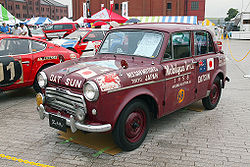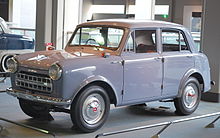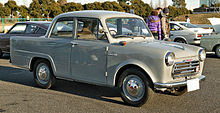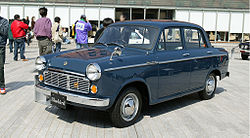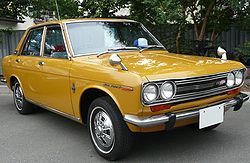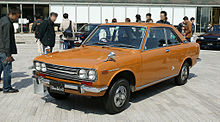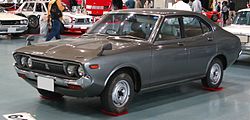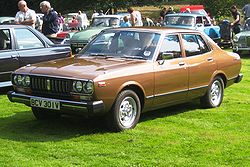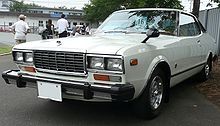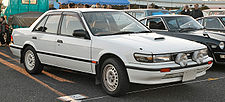- Nissan Bluebird
-
- This article incorporates information from the equivalent article on the Japanese Wikipedia.
Nissan Bluebird 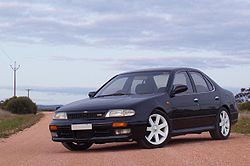
Manufacturer Nissan Production 1957–2001 Successor Nissan Bluebird Sylphy Class compact (car) Body style 2-door coupe
4-door hardtop/Sedan/wagonThe Nissan Bluebird is a compact- to medium-sized car launched in 1957. The nameplate still exists today on the Nissan Pulsar-based Nissan Bluebird Sylphy in Japan, and on the U13-based Nissan Bluebird in mainland China.
The Bluebird's traditional competitor was the Toyota Corona from almost the very beginning of the product line. The Bluebird was originally developed to compete with the Corona, as the Corona was developed to continue offering a sedan used as a taxi as the Toyota Crown began to grow in size. Every generation of the Bluebird has been available as a taxi, duties that are shared with base level Nissan Cedrics.
It is one of the longest-running nameplates from a Japanese automaker. It even spawned the S130 Fairlady Z/280ZX, which in turn spawned the Maxima (originally 910 Bluebird/S130 Fairlady Z based), the 160J/710/Violet/Auster/Stanza line, and the US-built Altima line.
Contents
Export and foreign-built model names
Export versions were sold variously as the Datsun 510, Datsun 180B (with 160B and 200B versions) and the Datsun Bluebird. The Nissan Bluebird nameplate began appearing around 1982 as the Datsun marque was phased out in favour of Nissan.
From 1981 to 1985, Australia followed the Japanese convention by calling its car the Bluebird, and had a unique, facelifted rear-wheel-drive version for 1984 and 1985. That car was replaced in 1986 by the Nissan Pintara. It would be replaced by the successive Bluebird, also called Pintara, until 1992; then the range was brought in line with the Japanese model, for the U13 series from 1993 to 1997. In an unusual twist, brought about under the short lived Button Plan, the Pintara was also rebadged for Ford Australia as the Ford Corsair, reviving a Ford UK nameplate last used in the 1960s.
In the United States, the Bluebird was eventually sold as the Nissan Stanza. In 1992, the Stanza became the Nissan Altima. Currently, the Bluebird is not sold in North America; in 1998, the Altima was completely redesigned, becoming a model unique to the North American market.
The Bluebird sold in Europe between 1986 and 1990 was in fact a rebadged Nissan Auster—this was replaced by the Primera in Nissan's European line-up in 1990.
A six-cylinder version called the Maxima was released in the 1980s and became a separate model.
History
210/211 series
Datsun 1000 (210 series) Manufacturer Datsun Production 1957-1959 Class compact Body style sedan Layout FR layout Engine 988 cc 35 hp (26 kW) straight-4 Nissan C engine Transmission 4-speed manual Wheelbase 2,220 mm (87 in) Length 3,860 mm (152 in) Width 1,466 mm (57.7 in) Height 1,535 mm (60.4 in) Curb weight 925 kg (2,040 lb) max Although Nissan's own materials indicate that the Bluebird name emerged in 1959, some records show that the name first adorned a 988 cc, 34 hp (25 kW) four-door sedan in 1957, which was part of the company's 210 series. Its engine was based on an Austin design, as Nissan had been building the Austin A50 Cambridge under licence in the 1950s.
The 210 was known for doubling Nissan's production at the time and was the first Nissan to be exported to the United States. In some markets, this model was exported as the Datsun 1000. It was the first passenger car to be built in Taiwan, by the fledgling Yue Loong works, as the 1960 YLN 701 Bluebird.[1]
The 210 established an early reputation for reliability, with two of them winning the 1,000 cc class in the 1958 Australia Mobilgas Rally.
The 210 had succeeded the 110 series, sold as a two- and four-door sedan and offered from 1955 to 1957. This model bore the Convar or A110 model names and was powered by an 860 cc, 25 hp (19 kW) Nissan D10 four-cylinder engine. In some respects, the A110 is the forerunner of the modern Bluebird line. Incremental changes were denoted by 112 and 113 codes, with the last model a 113 with the 210's 1-litre C engine. The Datsun 114 was introduced in October 1957 as a low cost option to the 210 (the 114 used the 210's body except for the grille and exterior trim combined with the old D10 engine). Another low cost alternative was the Datsun 115 (lower specification version of the 211) and was similar to the 114 with the exception of a bigger rear window and slightly redesigned front turn signals. The same engine was used, but was improved to produce 27 hp (20 kW).
Subsequent models included the 211 (October 1958) with cosmetic changes. There was also a U220-series of small trucks based on the 210.
310 series
Datsun Bluebird 310 Also called Yue Loong Bluebird 704
Saenara Bluebird
Sinjin Sinsung-hoProduction 1960–1963 Assembly Hiratsuka, Kanagawa, JPN Body style 4-door sedan
5-door station wagonLayout FR layout Engine 1.0L C-1
1.2L E
1.2L E-1Transmission 3-speed manual (fully synchronized for 1961) Wheelbase 2,280 mm (90 in) Length 3,915 mm (154.1 in) Width 1,496 mm (58.9 in) Height 1,470 mm (58 in) Curb weight 900 kg (2,000 lb) Related Datsun 320 The Datsun Bluebird which debuted for August 1959 was an all-new car, and was available in Japan at the dealership sales channel Nissan Exhibition. The 310 series had a 1 L engine from the 210 model. The 310 was built from 1960-1963. There were three models built: 310 (1960), 311 (1961), and 312 (1962–1963). In Taiwan it also replaced the 701 and was known as Yue Loong Bluebird 704. The Datsun 312 was also sold in Korea.The 310 series was also built in South Africa at a factory in Rosslyn Pretoria in CKD form during 1962 and 1963.
In July 1960, a five-door station wagon was added (WP310). The P310 was powered by the 1.2L Nissan E engine. A smaller engine version (simply called "310") was powered by the 1.0L Nissan C engine. The P311 and P312 (powered by the 60 hp 1.2L Nissan E-1 engine) also had smaller engined versions ("311" and "312") that were powered by the 45 hp 1.0L Nissan C-1 engine. The 310 and 311 were equipped with a 3-speed manual transmission (fully synchronized for the 311 and 312). The station wagon was also available for the 311 and 312. The 312 was also available in a deluxe version (DP312). A trim model called the "Fancy Deluxe" (model code DP312-L) was marketed for the female driver; it featured a pale yellow exterior, pale yellow/grey interior, high heel shoe holder under the dash, a vanity mirror on the back of the driver's side sun visor, a turn signal relay that played music, curtains, automatic clutch, and bigger mirrors. By February 1961, a 1.2 L overhead-valve engine (codenamed E-1) became an option on a higher-trim DX model.
Styling tended to ape larger American cars. A very small number did make it to the United States, but were flops.
410/411 series
Datsun Bluebird 410 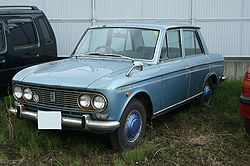
Also called Yue Loong YLN-705B Production 1964–1967 Assembly Hiratsuka, Kanagawa, JPN Body style 2-door sedan
4-door sedan
5-door station wagonLayout FR layout Engine 988 cc C-1 I4
1.2L E-1 I4
1.3L J13 I4 (SS)
1.6L R16 I4 (SSS)Transmission 3-speed column shift manual
4-speed close ratio floor shift manualWheelbase 2,380 mm (94 in) Length 3,995 mm (157.3 in) Width 1,490 mm (59 in) Height 1,415 mm (55.7 in) Curb weight 915 kg (2,020 lb) In September 1963, Nissan brought the Bluebird up-to-date with boxier styling (by Pininfarina), apeing the more European designs being produced in the United States. The 410 was built from 1964-1967.
Two models were built: 410 (1964–1965) with a combination rear lamp set consisting of round and rectangular lenses, and 411 (1965–1967) with higher mounted rectangular tail light sets. On both, the rear direction indicators were red or amber, according to market – New Zealand, which allows either, took the 410 with both and the 411 with red only. This Bluebird was one of the first Japanese car lines assembled in New Zealand, initially imported under a tariff/duty arrangement allowing 300 cars a year (the so-called '300 Club') with CKD kits built up by Motor Holdings at Mount Wellington in Auckland. The 410 series sedan and station wagon plus a light delivery van was assembled in South Africa at a factory in Rosslyn Pretoria.These cars were all in CKD format. A sporting model, the Bluebird SS, was launched in Japan in March 1964, with a tuned 1.2 L engine. The SS was available in a 2-door (RTK) or 4-door configuration (MTK). Two versions of the SS were built: the DP410-MTK/RTK and the DP411-MTK/RTK. The DP410 was powered by the 71 hp (53 kW) version of the 1.2 L Nissan E-1 engine. The 78 hp (58 kW) version of the J13 powered the DP411. All SS models were equipped with a 4-speed manual transmission.
Initially, only a four-door sedan and five-door station wagon were in the range, but a two-door was added in September 1964. The two-door SS was launched in February 1965. The two-door was not available in the U.S. The 410 and 411 were also available in a deluxe version (DP410 and DP411). The Fancy Deluxe version was also available. A DP411 SSS was entered in motor sport by the Datsun factory in South Africa [Pretoria] and was used as test car for Nissan Japan.A Datsun DP411 SSS was also entered in the 1964 Monte Carlo rally and driven by a South African called Ewold van Bergen.[see RSA motor sport history]
The base engine was enlarged to a 1.3 L unit in May 1965 and a 1.6 L SSS model was launched the same month. This began a line of famous Nissans in Japan, with the Bluebird SSS a mainstay of the range until its deletion in 2001.
In Taiwan the Bluebird 410 was built and sold as the Yue Loong YLN-705B.
510 series
Datsun Bluebird 510 Also called Datsun 510
Datsun 1600 (D)
Yue Loong YLN-706 (Yulon, TW)Production 1967–1971 Assembly Hiratsuka, Kanagawa, JPN Body style 4-door sedan
2-door coupé
4-door sedan
5-door station wagonLayout FR layout Engine 1.3L L13 I4[2]
1.6L L16 I4 [2]Transmission 4 speed manual all-synchromesh[3] Wheelbase 95.1 in (2,416 mm)[2] Length 162.2 in (4,120 mm)[2] Width 61.4 in (1,560 mm)[2] Height 55.2 in (1,402 mm)[2] Launched in August 1967, it was one of the most comprehensive Bluebird ranges in terms of body styles: a two-door sedan, a four-door sedan, a five-door station wagon, and a two-door coupé (added in November 1968). The "510" still enjoys considerable fame in the US.
Like its predecessors, the 510 Bluebird line was imported into New Zealand as a single 1.6-litre, four-speed manual Deluxe model, assembled from CKD kits by Campbell Industries (later Toyota New Zealand Thames assembly plant). Local content included glass, radiator, upholstery, carpet, paint, wiring and numerous other items. A few automatic and twin carburettor SSS versions were imported built-up from Japan, primarily for buyers who had access to funds overseas and could utilise the country's 'no remittance' new car purchase scheme to avoid lengthy waiting lists.The P510 sedan and coupe were built in South Africa [Pretoria] from 1969 to 1974 and had the L16 1600SSS twin carbs and the 1600 Deluxe single carb. An automatic gearbox model was also available for the deluxe range. The factory also made two versions of the 2 door coupe. They were a 1600GL and a 1800GL. The 1600GL had a single carb or twin carbs and 1800 cc cars had twin carbs The 1600sss were also used in motorsport as test cars for Nissan Japan. The cars were used in numerous motorsport rallies by Ewold van Bergen from Pretoria, South Africa, who was a test engineer for Nissan Japan.
610 series
Datsun Bluebird 610 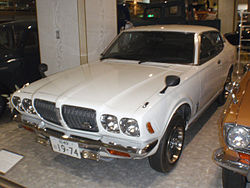
Datsun Bluebird Coupe (610 series)Also called Datsun 160B
Datsun 180B
Datsun 610 [4]Production 1971–1976 Body style 4-door sedan
2-door coupé
5-door station wagonLayout FR layout Engine 1.6L I4
1.8L I4
2.0L I6Wheelbase 2,500 mm (98 in) Length 4,215 mm (165.9 in) Width 1,600 mm (63 in) Height 1,415 mm (55.7 in) Curb weight 1,035 kg (2,280 lb) The 610 series was launched in Japan in August 1971 and was badged as the Datsun Bluebird-U. The meaning behind the U suffix is uncertain, but it has been suggested that it was an acronym for either User or Ultra. For the Japanese domestic market, the 610 was pitted against the second generation Toyota Corona Mark II. Also in Japan, the 610 was initially sold alongside the 510 but eventually replaced the 510. 610's were available in a 4dr, 2dr hardtop (HT), and five-door wagon. Trim levels in Japan were GL (Grand Luxe), SSS (Super Sports Sedan), DX (Deluxe) or STD (Standard). The 610 borrowed its suspension and drive train from the outgoing 510. Thus all 610's were equipped with the Nissan L-Series inline engines. Likewise, the 610 4dr & 2dr retained the class-leading, independent rear trailing arm design, while the wagon reused the rear live axle with leaf springs from the 510 wagon. In many export markets, including UK, Europe & Australia, the 610 was badged as the 160B or 180B with respect to particular engine displacement. From 1973-74, the USA was the only market outside of Japan to have its 610 HT models equipped with the unique, six-bulb tail lights that covered the entire rear panel, requiring the license plate to be mounted below the rear bumper. Most 610's world- wide came equipped with either a 4spd manual or 3spd automatic transmission, but a 5spd manual transmission was available in the Japan & Australia markets. As with the 510, SSS trim included misc. sport options and a higher output engine with twin-Hitachi carburetors. A Japan-only SSS-E model was equipped with Bosch EFI, and so was one of the first, mass-produced Nissan vehicles to be sold without a carburetor. Another 610 never exported was the inline-six -U-2000 GT and -U-2000 GTX(SAMEBLUE..SAME meaning Shark in Japanese). It came with stretched front end to accommodate the longer engine and featured a different grill and other aesthetic modifications, but this model was not available in a wagon.
New Zealand market cars initially were a single 1.8-litre 180B sedan, again with four-speed manual transmission and assembled from CKD kits under contract by Campbell's. A three-speed automatic – using a transmission made by Nissan Japan subsidiary JATCO – was later added as a factory option. Relaxed restrictions on car assembly kit imports and increasing affluence in NZ meant Campbell's, which also assembled Toyota, Renault, Rambler, Hino, Isuzu and Peugeot models over the years, could not meet demand so Nissan-Datsun (NZ) contracted Chrysler/Mitsubishi importer Todd Motors to assemble additional manual 180Bs at its Porirua factory alongside the Chrysler Valiant, Hunter, Avenger and Alpine model ranges and Mitsubishi Lancer sedan and Colt Galant coupe. The Todd-built cars gave Datsun dealers a new range of paint colours all different to those Campbell's offered.
A minor upgrade to the front suspension (offset strut tops) for the 610 led to slightly improved handling before the introduction of the 810. Racing History
A 610 4dr participated in the 1972 & 1973 East African Safari Rally. Bob Sharp drove his 610 HT race car to 2nd place overall in the SCCA B Sedan Championship for 1973 & 1974. The same car achieved a first place for the 1976 SCCA B-Sedan Championship but with Elliot Forbes-Robinson driving.
710 series
Shortly after the introduction of the 610, Nissan launched a new line of slightly smaller cars January 1973 utilizing parts and styling cues from the 610. This new line of cars was sold in various markets as the 140J/160J, Violet, or 710, evolving into the Nissan Stanza. The use of the 710 name was a source of confustion because it implied that the model was either a larger, upscale version of the 610 (it was the opposite) or a newer model in the Bluebird line.This car was also built in South Africa during 1973 to 1978 at the Rosslyn Datsun plant in the form of a 160U deluxe and SSS and 180U deluxe and SSS. As the Bluebirds traditional cross-town rival, the Toyota Corona split into a new model called the Toyota Carina, the Violet appeared shortly after the Carina did.
810 series
Datsun Bluebird 810
1979 Datsun Bluebird 1.8 GL Sedan (810 series)Also called Datsun 160B [5]
Datsun 180B [5]
Datsun 200B [6]
Datsun 810 [7]Production 1976–1979 Assembly Japan
Clayton, Australia [7]Body style 4-door saloon/sedan
2-door coupé
5-door wagon/estateLayout FR layout Engine 1.6L I4[3]
1.8L I4[3]
2.0L I4[6]
2.4L L24E I6Transmission 4 speed manual all-synchromesh[3] Wheelbase 98.4 in (2,499 mm)[3] Length 167.7 in (4,260 mm)[3] Width 64.2 in (1,631 mm)[3] Height 54.7 in (1,389 mm)[3] Curb weight 2,390 lb (1,084 kg)[3] The 810 was introduced in July 1976. Engine options were carried over but a 1.4 L was reintroduced in August 1978. Styling was an evolution of the 610's, with slightly squared off features but retaining a slight "coke bottle". No two-door sedan was available, but the four-door sedan, two-door hardtop coupé ( SSS Coupe) and five-door station wagon were offered.
The Bluebird 810 was sold in export markets as the Datsun 160B, Datsun 180B, Datsun 200B and Datsun 810.[7] Australian magazine Wheels calling the 200B 'a 180B with 20 more mistakes.'
At this time, with several UK auto-producers losing market share, Datsun had grabbed the headlines as the UK's leading car importer. The magazine Autocar road tested a 180B Bluebird and recorded a top speed of 101 mph (162 km/h) along with a 0-60 mph (0 – 96 km/h) time of 13.6 seconds.[3] The Datsun's overall fuel consumption for the test was 27.7 mpg (10.2 l/100 km).[3] For all three of these performance measurements, it was marginally better than the Ford Cortina 1600 GL which continued to dominate this sector in the UK, but both cars were beaten for speed and acceleration (though not for fuel economy) by the relatively crude Morris Marina 1.8HL.[3] It was probably more significant that the Bluebird had a manufacturer's recommended retail price, including sales taxes, of £2950 as against £3263 for the Ford and £3315 for the Morris.[3] The testers found the car matched the competition in most respects, though the brakes were criticised for being "not up to current standards".[3]
This Bluebird was the first to be assembled in Nissan New Zealand's own brand-new assembly plant at Wiri, South Auckland. It was originally built as a 180B but that was replaced by the two-litre 200B during the run. Automatic transmission was optional for both. Nissan also added its first luxury ZX version with this generation – features included velour upholstery, 'luxury' cut-pile carpet sourced locally and tinted glass. There was also, for the first time in Kiwi assembly, a wagon variant with mid-range trim and equipment.
910 series
Datsun Bluebird 910 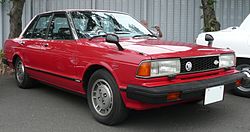
Also called Nissan Bluebird 910
Yue Loong Bluebird 911/912 (TW)[8]Production 1979 to 1986 [9] Assembly Hiratsuka, Kanagawa, JPN
Clayton, Victoria, Australia [10]Body style 4-door sedan [9]
5-door station wagon [9]
2-door coupé [9]Layout FR layout [9] Wheelbase 2.52m (99.5 in) Length Saloon 4.35 m (171.3 in)
Estate and Coupe: 4.40 m (173.2 in)Width 1.65 m (65.2 in) Height Saloon and Estate 1.40 m (55.2 in)
Coupe 1.38m (54.6in)The Bluebird 910, which was the last rear wheel drive Bluebird, featured simple clean-cut lines, unlike the "Coke Bottle" styling of its predecessor.[11] It did however retain the same engine range, the same McPherson strut suspension and the same 99-inch (2,500 mm) wheelbase as the 810.[11]
This car was made in South Africa[Pretoria]1978 to 1980 as well and was called the Datsun 1600J Deluxe,1800j deluxe or 1800J SSS Sedan which had the twin carb set up and a five speed gearbox.A staton wagon version with a 1600 cc engine was also made.The cars had the L16 or L18 engines.After a while the cars model name changed to the Datsun Stanza.The cars were all rear wheel drives with solid axle and coil springs.These cars were the last models to have the name DATSUN as the later models all had the name NISSAN due to the globel name change. This car was very popular as it reminded people of the Datsun P510 models made in 1969 to 1973 in South Africa.
Nissan began realigning its export names with its home market names with the 910 series in November 1979. The 'B' tags were dropped in favour of 'Bluebird', though the models were marketed as 'Datsun Bluebird' initially. For the export models, a 'Nissan' badge began appearing in 1981. However in Australia, where 130,000 910s were built between 1981 and 1986, the name change from Datsun Bluebird to Nissan Bluebird did not occur until 1983.[10]
After eight years the Bluebird returned to the Taiwanese market. Yulon had replaced the Bluebird with the Nissan Violet in 1971. The new model was considered to be in a new class and was now known as the Yue Loong Bluebird 911. Until then, Yue Loong had reserved the 900-series for the larger Laurels. After a facelift, the car became the 912.[12]
Nissan New Zealand assembled several versions of the Bluebird 910. These were shipped in CKD from Japan, including a top ZX model that was the first, and only, car to be assembled in the country with electrically adjustable Japanese domestic style 'hockey stick' rear view mirrors on the front guards (which had to be sent out after kit unpacking for a local specialist to stamp the mounting holes). NZ cars initially had the two-tone brown interior; this was switched to grey at the mid-life facelift when the top model's power exterior mirrors were relocated to the door mounting now universal today. Japan itself eventually phased out the mandatory wing-mount mirrors that also distinguished thousands of used cars imported from Japan into NZ in the late 1980s and early 90s.
U11 series
Nissan Bluebird U11 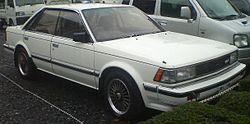
Also called Yue Loong Bluebird 931 (Yulon, TW) Production 1983-1990 Assembly Oppama, Japan
Clayton, Australia [7]Body style 4-door saloon/sedan
4-door hardtop
5-door wagon/estateLayout FF layout Engine 1.6L CA16 I4
1.8L CA18E/CA18 I4
1.8L CA18DET/CA18ET I4
2.0L CA20 I4
2.0L LD20 I4 diesel
2.0L VG20E/VG20ET V6Transmission 4 speed manual, 5 speed manual
3 speed automatic, 4 speed automaticWheelbase 2,550 mm (100 in) Length 4,500 mm (177 in) Width 1,697 mm (67 in) Height 1,370 mm (54 in) Curb weight 1,105 kg (2,436 lb) The Bluebird switched to front-wheel drive in October 1983, but retained the boxy styling of its predecessor. At the time, Nissan's design chief balked at curvy shapes and believed boxy ones would remain popular. With hindsight, that went directly against the trend and the market's obsession with drag coefficients.
The range was offered in four-door sedan, four-door hardtop and five-door station wagon forms. The coupé was deleted.
Australia made do with the 910 series, which was facelifted in 1985.
New Zealand marketing for the U11 proclaimed the vehicle as the 'Widetrack Bluebird', to differentiate it from its very similar-looking predecessor. Several Wiri-assembled models including a wagon were offered with 1.6 (base) or two-litre carburettor engines. The alloy head castings all had an unused location for a second spark plug per cylinder, eight-plug, fuel-injected versions of the same engines were used in some markets (US, Japan, Scandinavia) with stricter emission laws.
This model was offered in Europe for two years before Nissan began building the Auster as the Bluebird in England in 1986.
The U11 was sold as the Yue Loong Bluebird 931 in Taiwan.
Although the U11 sedans were replaced for the 1988 model year, the station wagon continued in to 1990.
The range was available with 1.6, 1.8 and 2.0L petrol engines. The VG20ET V6 was offered for the first time in Japan in 1984, in a model with an extended front end, called the Bluebird Maxima.This V6 was intercooled 2.0L V6 turbo.
In the United Kingdom, the following versions were offered:
- 1.8 DX (1984–86)
- 2.0 GL/GL estate/SGL (1984–86)
- 1.8 Turbo ZX (1984–86)
T12/T72 series
Nissan Bluebird T12/T72 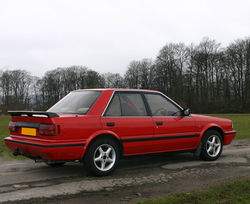 Main article: Nissan T12 / T72
Main article: Nissan T12 / T72The T12 and the later T72 Nissan Bluebird, is in fact a third generation Auster, rebadged and sold in Europe. However, its well known build quality and reliability and the influential role it had in what is now Europe’s most efficient car factory merits the T12/72 its Bluebird badge.
The T12 was introduced in Europe in 1985 as a replacement for the U11 Bluebird. From July 1986, the T12 was assembled from parts shipped in from Japan, at Washington, England. The saloon versions (four door) were available first and the hatchback (five door) became available in January 1987. Using the U11 platform, Bluebird Estates were also built at Washington. This model of Bluebird was a particular favourite with UK minicab drivers throughout the 1980s.[citation needed]
U12 series
Nissan Bluebird U12 Also called Yue Loong Bluebird 941 (Yulon, TW) Assembly Oppama, JPN Main article: Nissan Bluebird U12Nissan evolved the boxy shape of the U11 slightly, released in September 1987. This model was sold as the Nissan Pintara in Australia, replacing a larger Skyline-based model, from 1989 to 1993. There, it had been codenamed ‘Project Matilda’, leading the press to speculate it was a car developed uniquely for Australia—which was not the case. In Japan, a four-door sedan and four-door hardtop were offered, although Nissan of Australia did create a five-door Pintara 'Superhatch' model that was sold as the Bluebird in some export markets, including New Zealand. It was marketed as the 'Bluebird Aussie' in Japan, selling complete with a fluffy little koala, Aussie flag under the clock and other small touches.
Innovations for the U12 included the introduction of Nissan's mechanical four-wheel-drive system, called ATTESA and the ever popular SR20DET engine was introduced in the series 2 (HNU12) bluebirds (89-91). With the Maxima having been spun off into its own range, U12 Bluebirds were all four-cylinder models, with either a 1.6, 1.8 or 2.0 L petrol engine and also the option of an LD20 2.0l diesel. The sports and luxury versions came with a factory viscous LSD. Nissan made a turbocharged Bluebird from 1987 to 1990 named the RNU12, using the 1809 cc DOHC CA18DET that was sold in Japan and New Zealand. It also used ATTESA.
Australian models came with the CA20E SOHC 2.0l EFI and KA24E SOHC 2.4l EFI motors. Sadly for Nissan Australia, Project Matilda was not the success it had hoped, even with a twin built for Ford Australia called the Corsair, which was even less successful. This led to the collapse of Nissan’s Australian manufacturing operations in the early 1990s. Most of the early Bluebirds of this generation sold in New Zealand were again assembled locally from CKD kits, as had been the case with almost all NZ-bound cars since the first generation in the early 1960s. The Japanese-made, NZ-assembled cars were replaced by Australian made U12 sedans at 'facelift' time though the Kiwi-built wagon, a body variant not made in Australia, carried on. NZ trim levels included SGS and ZX; like rival Toyota Australia, Nissan Australia, which ceased local manufacturing in 1994, was willing to build uniquely specified and badged models for its trans-Tasman customer.
The U12 was also sold in North America as the Nissan Stanza.
Trim levels of the Australian U12 Pintara were as follows: GLi: 2.0L manual 5 speed, high mounted brake light, AM/FM radio cassette Executive: 2.0L auto 4 speed, as above plus, power steering, remote boot release T: 2.4L manual or auto, as above plus 4 wheel disc brakes, tacho, split fold rear seat Ti: 2.4L manual or auto, as above plus limited slip differential, cruise control, climate control, central locking, electric windows, graphic equaliser, fog lamps, alloy wheels TRX: 2.4L manual or auto, as above plus sports seats, sports suspension, body kit, alarm, 6Jx14" alloy wheels (all other models have 5.5Jx14" wheels) Note: All models were available as a 4 door sedan and 5 door hatch, except the TRX, which was only available as a 4 door sedan. Note 2: The Corsair was available as a GL (CA20) and Ghia (KA24, and similar features as the Ti).
U13 series
Nissan Bluebird U13 
Assembly Oppama, JPN Main article: Nissan Bluebird U13The U13 series was launched in Japan in September 1991 as a four-door sedan and four-door hardtop. The two models were visually distinct: the four-door sedan had curves where its U12 predecessor had edges, while the hardtop, called the Nissan Bluebird ARX, had more traditional styling.
Several versions of the sedan, including the first local Bluebird to have standard factory-fitted air conditioning (automatic climate control in this case) and optional locally supplied leather upholstery, were assembled in Fiji from CKD packs imported from Japan. At launch, some local motoring writers criticised Nissan NZ's decision to fit luxury equipment items instead of airbags in top versions but the company insisted there was not yet sufficient retail or fleet buyer demand.
Several Japanese models included an All Wheel Drive version (ATTESA).
This generation of Bluebird was used by Nissan USA as the basis for the first generation Nissan Altima.
U14 series
Nissan Bluebird U14  Main article: Nissan Bluebird U14
Main article: Nissan Bluebird U14Nissan switched to boxy styling for the U14 Bluebird for January 1996. The American Altima had different front and rear ends, in keeping with its sports sedan positioning. But in its home market, the Bluebird was targeted more at buyers who favoured the formality of larger Japanese sedans. However, the SSS trim was retained, though it no longer referred to a truly sporting model in the range. To fit in with a lower bracket in Japanese taxation legislation, the U14 retained a 1,700 mm (66.9 in) width.
Only a four-door sedan was offered. The hardtop, and the option of a 1.6 L engine, were removed. The Nissan Hyper CVT automatic transmission was available in this generation. Some models had a 1973 cc diesel CD20E engine.
The Nissan Bluebird platform ended in 2001, and was replaced by a smaller platform using the Bluebird name, called the Bluebird Sylphy.
G10 series
Nissan Bluebird Sylphy G10 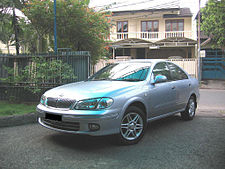
The G10 Bluebird Sylphy is basically the N16 Pulsar with more luxury touch and a vertical chrome grille. The G10 Bluebird Sylphy uses Nissan's FF-S platform. Engine choice are the 1.5 QG15DE, 1.6L QG16DE, 1.8 L QG18DE, and the 2.0 L QR20DE. A 5-speed manual transmission is only for the 1.5 L and 1.6 L cars, others have a 4-speed automatic transmission. 4WD is only offered for the 1.8 L model.
For export, similar cars were sold as Pulsar in Australia and New Zealand, Sunny in Hong Kong, Singapore, Thailand, and Middle East, Sentra in Taiwan, the Philippines, Malaysia, Indonesia and Almera in Brunei. The Almera sedan was also built in England and sold primarily in eastern and southern Europe while its hatchback variants, also called Almera, also made in the UK, were most popular there and in northern and western Europe where sedans are less popular.
For 2004, the Bluebird Sylphy received minor change with revised grille, and all-new rear end with Teana-like tail lights.
G11 series
Nissan Bluebird Sylphy G11 Also called Nissan Bluebird Sylphy (Japan)
Nissan Bluebird (Yulon, RC)
Nissan Sylphy (Malaysia)Assembly Tochigi, Tochigi Prefecture, Kanto region, JPN
Miaoli City, Miaoli County, ROCThe G11 Bluebird Sylphy was launched at the Tokyo Motor Show 2005; it uses Nissan B platform.
The Nissan Bluebird Sylphy uses the same engine as the Nissan Tiida/Versa/Latio, which is the HR15DE 1.5 L engine and a whole new MR20DE 2.0 L engine. The 2.0 L version of Nissan Bluebird Sylphy uses Nissan's X-Continuously Variable Transmission (X-CVT). This combination results in smooth and powerful acceleration combined with the fuel economy of a 1.8 L engine.
The Sylphy has the most spacious interior space and the biggest boot (504 L) in its class. The rear legroom is almost as big as the Nissan Teana and Toyota Camry.
Starting from 2008, the Bluebird Sylphy is also available for the export market, as the Nissan Sylphy. The Sylphy is sold in China, and some South East Asian countries.
Notes and references
- ^ Company History "Chronology". Yulon Motors. http://www.yulon-motor.com.tw/company_e/history.asp Company History. Retrieved 2011-02-01.
- ^ a b c d e f "OHC is the fashion: Japan's Datsun Bluebird in latest form as 1300 and 1600". Autocar 127 (nbr 3747): Pages 25–26. 7 December 1967.
- ^ a b c d e f g h i j k l m n "Autotest Datsun 180B Bluebird: Completely new body, with larger windows and improved visibility for Datsun's mid-range car. Average performance cuped with excellent economy and cheapest petrol. Handling improved at expense of ride, now almost harsh. Brakes not up to current standards". Autocar 147 (nbr4217): Pages 36–40. 3 September 1977.
- ^ Canadian Brochure Datsun 610 1973 Retrieved on 26 July 2011
- ^ a b Graham Robson, A-Z of Cars of the 1970s, Bay View Books, 1990, page 49
- ^ a b Datsun 200B brochure Retrieved on 14 August 2011
- ^ a b c d Nissan Bluebird (810) Retrieved on 14 August 2011
- ^ World Cars 1982. Pelham, NY: L'Editrice dell'Automobile LEA/Herald Books. 1982. pp. 335–336. ISBN 0-910714-14-2.
- ^ a b c d e Nissan Bluebird (910) Retrieved from www.autocade.net on 11 April 2011
- ^ a b Tony Davis, Aussie Cars, 1987, page 163
- ^ a b Martin Lewis, A-Z of Cars of the 1980s, 1994, page 102
- ^ Büschi, Hans-Ulrich, ed (March 10, 1983). Automobil Revue '83. 78. Berne, Switzerland: Hallwag, AG. p. 560. ISBN 3-444-06065-3.
External links
- Drive.com.au Nissan Bluebird Review
- Japanese Imports Safety Recalls
- RatDat.com – paint colors, sales brochures, and model names
- http://www.earlydatsun.com/index.html
Nissan Motor Company Vehicles Current370Z • Advan • Altima • Aprio • Armada • Atlas • Bluebird • Bluebird Sylphy • Cabstar • Caravan • Civilian • Clipper • Cube • Dualis • Elgrand • Frontier • Freeson • Fuga • GT-R • Juke • Lafesta • Leaf • Livina Geniss • Maxima • March • Murano • Moco • Navara • Note • NV200 • NV400 • Otti • Paladin • Pathfinder • Patrol • Qashqai • Quest • Rogue • Safari • Sentra • Serena • Skyline • Teana • Tiida • Titan • Urvan • Versa • Wingroad • X-Trail • XterraPastDC-3 • 100NX • 1200 • 310 • 180SX • 200SX • B-210 • 240SX • 240Z • 280ZX • 300C • 300ZX • 350Z • 510 • 810 • Almera • Almera Tino • Altra (EV) • Avenir • Auster • Bassara • Be-1 • Caball • Cablight • Cedric • Cefiro • Cherry • Cima • Crew • Datsun Truck • Echo • Expert • Fairlady • Figaro • Gazelle • Gloria • Hardbody Truck • Hypermini • Homy • Interstar • Junior • Largo • Laurel • Leopard • Liberty • Mistral • Multi • NX • Pao • Pintara • Pino • Platina • Prairie • Presage • Presea • Primera • President • Pulsar • Pulsar GTI-R • R390 GT1 • R'nessa • Rasheen • Roadster-Road Star • S-Cargo • Saurus • Saurus Jr • Silvia • Sileighty • Skyline GT-R • Stanza • Stagea • Sunny • Terrano • Terrano II • Vanette • VioletConcept126X • 216X • 270X • 300 Bambu • 315-a • AA-X • Actic • AD-1 • AD-2 • AL-X • Alpha T • Amenio • AQ-X • AP-X • ARC-X • AXY • AZEAL • Bevel • Boga • C-Note • Chapeau • Chappo • Cocoon • CQ-X • Crossbow • CUE-X • Cypact • Duad • Dunehawk • Effis • ESV • Evalia • EV Guide II • EV Truck • FEV • FEV-II • Foria • Forum • Fusion • Gobi • GR-1 • GR-2 • GT-R • ideo • Intima • Jikoo • Judo • Jura • Kino • KYXX • Land Glider • LEAF • LUC-2 • MID4 • Mixim • mm.e • Moco • Nails • NCS • NEO-X • NRV-II • NX-21 • NV2500 • Pivo • Pivo 2 • Qazana • Redigo • Round Box • Serenity • Sport Concept • Stylish VI • Terranaut • Tone • Townpod • Trailrunner • TRI-X • URGE • UV-X • XIX • XVL • Yanya • ZarootEngines GRX-3 • UD12 • VRT35Marques Nissan • InfinitiSubsidiaries
and divisionsSee also ATTESA • Datsun • HICAS • Prince • Renault-Nissan Alliance • Nissan Shatai • UD Nissan Diesel • VVL • VVEL • dCi
 Category ·
Category ·  Commons
CommonsNissan car timeline, European market, 1980s–present Type 1980s 1990s 2000s 2010s 0 1 2 3 4 5 6 7 8 9 0 1 2 3 4 5 6 7 8 9 0 1 2 3 4 5 6 7 8 9 0 1 Supermini Micra K10 Micra K11 Micra K12 Micra K13 Small family car Cherry N10 Cherry N12 Sunny B310 Sunny B11 Sunny N13 Sunny N14 Almera N15 Almera N16 Tiida C11 Large family car Stanza T11 Bluebird 910 Bluebird U11 Bluebird T12/T72 Primera P10 Primera P11 Primera P12 Executive car Laurel C31 Laurel C32 Maxima J30 Maxima QX A32 Maxima QX A33 Teana J31 Teana J32 Coupé Silvia S110 Silvia S12 200SX S13 200SX S14 Sports car 280ZX 300ZX Z31 300ZX Z32 350Z Z33 Mini MPV Note Compact MPV Prairie M10 Prairie M11 Almera Tino Large MPV Serena C23 Serena C24 Serena C25 Mini SUV Juke Crossover SUV Qashqai Qashqai+2 X-Trail T30 X-Trail T31 Murano Z50 Murano Z51 Terrano WD21 Pathfinder R50 Pathfinder R51 Off-roader Terrano II Patrol 160 Patrol Y60 Patrol Y61 Patrol Y62 Categories:- Nissan vehicles
- All wheel drive vehicles
- Vehicles with four wheel steering
- Vehicles with CVT transmission
- Vehicles introduced in 1959
Wikimedia Foundation. 2010.

